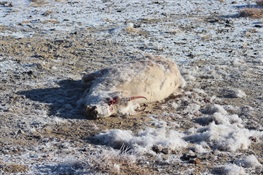 Credit: WCS Mongolia Credit: WCS Mongolia
Feb 7, 2020
1. The 2016-2017 introduction of peste des petits ruminants virus (PPRV) into livestock in Mongolia was followed by mass mortality of the critically endangered Mongolian saiga antelope and other rare wild ungulates.
2. To assess the nature and population effects of this outbreak among wild ungulates, researchers collected clinical, histopathologic, epidemiologic, and ecological evidence that suggested spillover of virus from livestock at multiple locations and time points and subsequent spread among wild ungulates.
3. With estimates of saiga abundance suggested a population decline of 80 percent, consideration of the entire ungulate community (wild and domestic) is essential for elucidating the epidemiology of PPRV in Mongolia, addressing the threats to wild ungulate conservation, and achieving global PPRV eradication.
WCS Media Contact: Stephen Sautner, 7182203682, ssautner@wcs.org
Study and Journal: "Outbreak of peste des petits ruminants virus among critically endangered Mongolian saiga and other wild ungulates, Mongolia, 2016-2017" from Emerging Infective Diseases
WCS Co-Author(s): Mathieu Pruvot (Lead)
, WCS Wildlife Epidemiologist
; Amanda Fine, Associate Director Asia -- Wildlife Health Program; Charlotte Hollinger, Associate Pathologist; Samantha Strindberg, Wildlife Statistician; Batchuluun Damdinjav, WCS Mongolia Program; Bayarbaatar Buuveibaata, WCS Mongolia Program; Dee McAloose, Head Pathology Dept.; Enkhtuvshin Shiilegdamba , WCS Mongolia Program
|
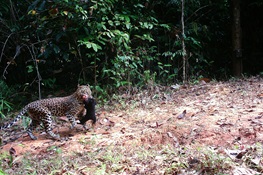 Credit: Hla Naing, WCS Myanmar Credit: Hla Naing, WCS Myanmar
Feb 7, 2020
1. During a camera-trap survey in 2018 in Htamanthi Wildlife Sanctuary, Myanmar, researchers photographed a male leopard (Panthera pardus) carrying a sun bear cub by the throat – the first reported case of probable predation on sun bears by leopards.
2. A literature review showed that consumption of sun bears and Asiatic black bears (Ursus thibetanus) by tigers (P. tigris) was widespread in Southeast Asia, whereas consumption of both bear species by leopards and dholes (Cuon alpinus) was less common.
3. Future research should examine interspecific relationships between sun bears and large felids to better understand what, if any, impacts large felids have on sun bear ecology.
WCS Media Contact: Stephen Sautner, 7182203682, ssautner@wcs.org
Study and Journal: "Large carnivores as potential predators of sun bears." from Ursus
WCS Co-Author(s): Hla Naing (Lead)
, Landscape Coordinator, WCS Myanmar
; Saw Htun , WCS Myanmar Country program Director
|
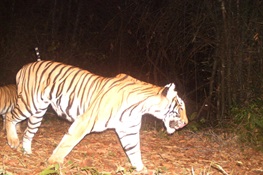 Credit: WCS Thailand Credit: WCS Thailand
Feb 7, 2020
1. Researchers looked at the amount of time spent active per day for 128 species of mammals in 19 tropical forests in 15 countries to see if there was a correlation between activity range and body mass.
2. Empirical data showed that activity ranges scaled positively with body mass for carnivores herbivores, omnivores and insectivores.
3. Despite the many factors that shape animal activity at local scales, they found a general pattern showing that large carnivores need more time active in a day to meet their energetic demands.
WCS Media Contact: Stephen Sautner, 7182203682, ssautner@wcs.org
Study and Journal: "On the scaling of activity in tropical forest mammals" from Oikos
WCS Co-Author(s): Tim O'Brien
, Senior Scientist, Conservation Measures
; Julia Salvador , WCS Ecuador
|
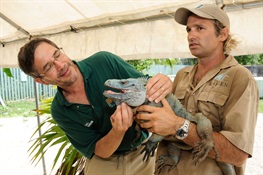 Credit: Julie Larsen Maher/WCS Credit: Julie Larsen Maher/WCS
Feb 7, 2020
1. Researchers examined healthy captive and wild blue iguanas (Cyclura lewisi) from Grand Cayman, CaymIslands and found a variety of endoparasites regardless of age, sex, or captive vs wild status, with no type found exclusively in either captive or wild populations.
2. Ectoparasites from wild adults included adult ticks (Amblyomma torrei) and a single adult mite (Hirstiella trombidiformis).
3. All are new host records for this species and Grand Cayman; knowledge of parasite status of captive and wild populations is important to evaluate the relative risk of introduction of captive animals into wild populations.
WCS Media Contact: Stephen Sautner, 7182203682, ssautner@wcs.org
Study and Journal: "Parasites of the blue iguana (Cyclura lewisi) from Grand Cayman Island" from Journal of Zoo and Wildlife Medicine
WCS Co-Author(s): Paul Calle
, WCS Vice President for Health Programs and Chief Veterinarian
|
 Credit: Julie Larsen Maher/WCS Credit: Julie Larsen Maher/WCS
Feb 7, 2020
1. Protecting and restoring natural capital—Earth’s lands, waters, and biodiversity, and the life-supporting goods and services that flow from these—have been promoted by many as the best hope for conserving biodiversity while also supporting sustainable, inclusive growth.
2. Evidence is growing that illuminating the ways in which people depend on nature for their well-being can motivate efforts that improve both.
3. Creative yet highly dispersed innovation has shown glimpses of what is possible.
WCS Media Contact: Stephen Sautner, 7182203682, ssautner@wcs.org
Study and Journal: "Scaling pathways for inclusive green growth" from Green growth that works
WCS Co-Author(s): Enkhtuvshin Shiilegdamba
, WCS Mongolia Country Director
; Ray Victurine , Director Business and Conservation, WCS Conservation Solutions
|
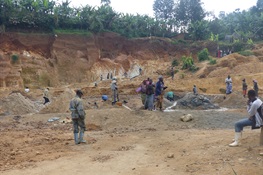 Credit: Fidèle Kavuba Credit: Fidèle Kavuba
Feb 7, 2020
1. Researchers estimate that mining concessions now take up 33 percent of the Albertine Rift – one of Africa’s most biodiverse regions – and that some concessions harbor species with restricted ranges that need to be protected.
2. The current protected area network covers 134,246 km2; an additional 64,586 km2 would be required to ensure the conservation of all threatened and endemic species outside the parks and wildlife reserves; but to avoid mining concessions, this increases to 145,704 km2 – an area larger than the existing protected areas.
3. The authors conclude that mining concessions should be challenged by the conservation community.
WCS Media Contact: Stephen Sautner, 7182203682, ssautner@wcs.org
Study and Journal: "Conservation planning for Africa's Albertine Rift: Conserving a biodiverse region in the face of multiple threats" from Oryx
WCS Co-Author(s): Samuel Ayebare
, Data Analysis and Oil Projects Manager, WCS Uganda
; Deo Kujirakwinja , Project Manager Democratic Republic of Congo
|
 Credit: Jon Beckmann Credit: Jon Beckmann
Feb 7, 2020
1. Researchers tested hair samples to determine how black bears (Ursus americanus) coexist with humans and increasing urban sprawl in western Nevada where hotels, casinos, restaurants, and homeowners dispose large quantities of high-protein, calorie-rich foods, often in unsecured waste containers.
2. They found only a 3.8 percent difference in the median use of human foods between urban and wildland bears, but great variability for individual bears in each location category.
3. The results affirmed that to effectively address human–bear conflicts officials should emphasize exclusion of human food attractants on a year-round basis and further try to understand factors affecting individual bear use of garbage.
WCS Media Contact: Stephen Sautner, 7182203682, ssautner@wcs.org
Study and Journal: "Assimilated diet patterns of American black bears in the Sierra Nevada and western Great Basin, Nevada, USA" from Ursus
WCS Co-Author(s): Jon Beckmann
, Director of Science, Rocky Mountain West Program
|
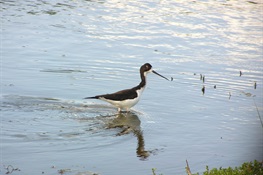 Credit: Copyright J. Michael Reed Credit: Copyright J. Michael Reed
Feb 7, 2020
1. Researchers tested for density dependence – population growth rates dependent on density of – for Hawaiian stilts (Himantopus mexicanus knudseni) an endangered subspecies of the Black‐necked stilt endemic to the Hawaiian Islands.
2. The analysis of reproduction data revealed a strong negative effect of local adult density on nest success (proportion of nests hatching at least one chick) at Kealia National Wildlife Refuge on Maui, where few alternative breeding habitats are available, but no such effect at another site where many nearby alternative wetlands are available.
3. These results across independent datasets and analytical approaches support the hypothesis that Hawaiian stilts exhibit density dependence across their range.
WCS Media Contact: Stephen Sautner, 7182203682, ssautner@wcs.org
Study and Journal: "Multiple sources of evidence for density dependence in the endangered Hawaiian stilt (Himantopus mexicanus knudseni)" from Population Ecology
WCS Co-Author(s): Gautam Surya
, Adjunct Conservation Instructor, AIP
|
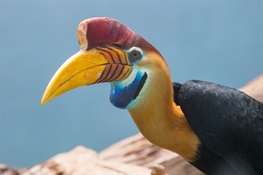 Credit: Julie Larsen Maher/WCS Credit: Julie Larsen Maher/WCS
Feb 7, 2020
1. Researchers assessed the magnitude and extent of recent change within protected areas, key biodiversity areas, and the habitat range of 308 lowland forest specialist birds in Sundaland, a global hotspot of biodiversity in Southeast Asia, finding an exceptionally high human footprint – a further deepening of the biodiversity crisis across the region.
2. Using the most recent human footprint dataset, they found that 70 percent of Sundaland has been heavily modified by humans, representing a 55 percent increase in areas under intense human pressure since 1993, with areas under intense human pressure covering on average 50 percent of the extent of key biodiversity areas, 78 percent of each protected area, and 38 percent of the range of lowland forest specialist birds.
3. The results imply that the actual level of protection by protected areas is only one‐third to half of that on paper once human footprint is accounted for, with those protected areas managed strictly for biodiversity conservation presented the largest increases in human pressures.
WCS Media Contact: Stephen Sautner, 7182203682, ssautner@wcs.org
Study and Journal: "Severe human pressures in the Sundaland biodiversity hotspot" from Conservation Science and Practice
WCS Co-Author(s): James Watson
, Director, Science and Research Initiative
|
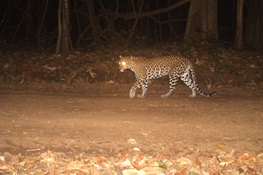 Credit: WCS Thailand Credit: WCS Thailand
Jan 16, 2020
1. Using camera trap data, researchers analyzed the behavioral interactions between leopards (Panthera pardus), their prey, and tigers to determine if leopards fine-tune their activity to maximize contact with four prey species (sambar; wild boar; barking deer; banteng) while avoiding tigers; and if prey alter their temporal activity in response to variation in their relative abundance ratio with leopards.
2. They found that differences in tiger relative abundance did not appear to impact the temporal activity of leopards, and that leopards had highest activity at dawn and dusk – a behavior that appears to be a compromise to provide access to diurnal wild boar and barking deer and nocturnal sambar and banteng.
3. This is the first study in Southeast Asia to quantify spatial and temporal interactions between the leopard, its primary ungulate prey, and the tiger and provides new insights for conserving this declining subspecies.
WCS Media Contact: Stephen Sautner, 7182203682, ssautner@wcs.org
Study and Journal: "Spatial and temporal analysis of leopards (Panthera pardus), their prey and tigers (Panthera tigris) in Huai Kha Khaeng Wildlife Sanctuary, Thailand" from Folia Oecologica
WCS Co-Author(s): Saisamorn Apinya (Lead)
, Wildlife Monitoring Coordinator, WCS Thailand
; Anak Pattanavibool , Program Director, WCS Thailand
|
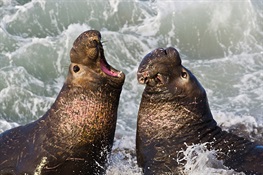 Credit: ©Michael "Mike" L. Baird/Wikimedia Commons Credit: ©Michael "Mike" L. Baird/Wikimedia Commons
Jan 16, 2020
1. Northern elephant seals produce loud, stereotyped calls during breeding seasons.
2. Researchers measured calls of competing male seals on three different sound level pressure metrics within context of biotic and abiotic ambient noise.
3. Results indicated that male seals emit airborne calls with little variation in call amplitude with no detected adjustment to compensate for higher background noise levels (no Lombard effect, which is when animals either call louder or change pitch to be heard above background noise); these findings reinforce the view that northern elephant seal calls serve as indicators of size, status, and motivation.
WCS Media Contact: John Delaney, 7182657908, jdelaney@wcs.org
Study and Journal: "High amplitude vocalizations of male northern elephant seals associated ambient noise on a breeding rookery" from The Journal of the Acoustical Society of America
WCS Co-Author(s): Stephen Insley
, Arctic Research Associate, WCS Canada
|
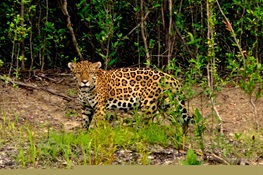 Credit: Valciney Martins de Oliveira Credit: Valciney Martins de Oliveira
Jan 16, 2020
1. Researchers provided the first indication of biodiversity impacts of increased ethanol demand, and related sugarcane cultivation, in Brazil – which is useful for policy makers and ethanol producers aiming to mitigate impacts.
2. Decreased potential species richness due to increased ethanol demand in 2030 was projected for about 19,000 km2 in the Cerrado, 17,000 km2 in the Atlantic Forest, and 7000 km2 in the Pantanal.
3. In the Cerrado and Atlantic Forest, the biodiversity impacts of sugarcane expansion were mainly due to direct land-use change; in the Pantanal, they were largely due to indirect land-use change, but overall biodiversity impact of increased ethanol demand was projected to be smaller than the impact of other drivers of land-use change.
WCS Media Contact: Stephen Sautner, 7182203682, ssautner@wcs.org
Study and Journal: "Biodiversity impacts of increased ethanol production in Brazil" from Land
WCS Co-Author(s): Daniele Baisero
, Conservation Solutions
|
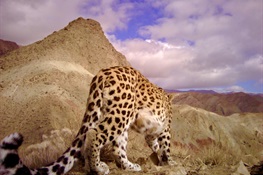 Credit: IR Iran DoE Credit: IR Iran DoE
Jan 16, 2020
1. Researchers investigated the influence of vertical relief and three-dimensional landscape features on the home range patterns of Persian leopards (Panthera pardus saxicolor) using GPS telemetry-tracking and globally-available digital elevation models (DEMs).
2. They found that calculating only planimetric (i.e. geographical features independent of elevation such as rivers and lakes) approaches may be underestimating aspects of animal ranging behavior and ecology.
3. They conclude that topography should be considered, not as an ancillary metric, but as an important aspect of home range calculation.
WCS Media Contact: Stephen Sautner, 7182203682, ssautner@wcs.org
Study and Journal: "Vertical relief facilitates spatial segregation of a high density large carnivore population" from Oikos
WCS Co-Author(s): Luke Hunter
, Executive Director, WCS Big Cats Program
|
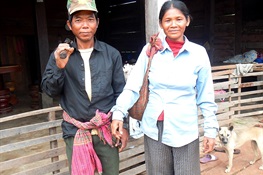 Credit: Emilie Beauchamp Credit: Emilie Beauchamp
Jan 16, 2020
1. Researchers present an analysis of household perceptions of land issues in 20 villages across different conservation and development contexts in Northern Cambodia, assessing whether conservation and development interventions, such as economic land concessions, influence perceptions of land issues.
2. Highlights of the findings: large-scale protected areas do not calm insecurity about land issues, but some village-based payment for environmental services projects do.
3. Ultimately, evidence from perception studies can help address current concerns and shape future conservation activities.
WCS Media Contact: Stephen Sautner, 7182203682, ssautner@wcs.org
Study and Journal: "Investigating perceptions of land issues in a threatened landscape in Northern Cambodia" from Sustainability
WCS Co-Author(s): Tom Clements
, WCS Conservation Solutions
|
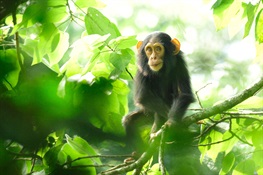 Credit: Julie Larsen Maher/WCS Credit: Julie Larsen Maher/WCS
Jan 16, 2020
1. Herpesviruses are thought to have evolved in very close association with their hosts, particularly for cytomegaloviruses (CMVs; genus Cytomegalovirus) which infects primates.
2. Researchers screened all 9 African great ape species/subspecies, using 675 fecal samples collected from wild animals to see if chimpanzees and gorillas might have mutually exchanged CMVs in the past.
3. The model best supported by the data involved the transmission of a gorilla CMV to the panine (chimpanzee and bonobo) lineage more than 800,000 years ago, adding to a growing body of evidence suggesting that viruses with a double-stranded DNA genome often jumped between hominine lineages over the last few million years.
WCS Media Contact: Stephen Sautner, 7182203682, ssautner@wcs.org
Study and Journal: "Cytomegalovirus distribution and evolution in hominines" from Virus Evolution
WCS Co-Author(s): Deo Kujirakwinja
, WCS Congo Program
; Gullain Mitamba, WCS Congo Program; Emmanuel Muhindo , WCS Congo Program
|
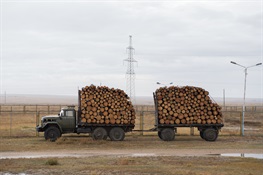 Credit: Julie Larsen Maher/WCS Credit: Julie Larsen Maher/WCS
Jan 16, 2020
1. Growth-inducing infrastructure, such as electrical transmission lines, and roads open intact areas, induce or intensify industrial development, and accelerate carbon emissions.
2. Yet decision makers often ignore the secondary, growth‐induced effects and full range of impacts, even though they can outweigh the impacts of the initial development.
3. In this study, researchers identify the characteristics of growth‐inducing infrastructure and provide an overview of methods and policy that can facilitate a deliberate assessment of these keystone decisions.
WCS Media Contact: Stephen Sautner, 7182203682, ssautner@wcs.org
Study and Journal: "Growth‐inducing infrastructure represents transformative yet ignored keystone environmental decisions" from Conservation Letters
WCS Co-Author(s): Justina Ray
, President, WCS Canada
; James Watson , Director, WCS Science and Research Initiative
|
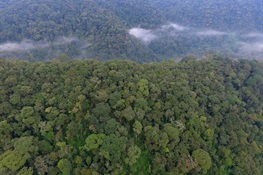 Credit: WCS Rwanda Program Credit: WCS Rwanda Program
Jan 16, 2020
1. Researchers documented a decline in ecosystem services (ES) in Rwanda over a 25-year period mostly due to conversion of forests to croplands, and were most pronounced from 1990 to 2000 and again from 2010 to 2015.
2. The results quantify nationwide ES trends, their implications for key water‐dependent industries, and the importance of protected areas in safeguarding ES flows and potential supply in Rwanda.
3. They also provide data that can be integrated with existing land, water, and economic accounts for Rwanda, as well as a baseline to inform development strategies that better link economic and environmental goals.
WCS Media Contact: Stephen Sautner, 7182203682, ssautner@wcs.org
Study and Journal: "Towards ecosystem accounts for Rwanda: Tracking 25 years of change in flows and potential supply of ecosystem services" from People and Nature
WCS Co-Author(s): Mediatrice Bana
, Sustainable Conservation Finance Manager, WCS Rwanda
|
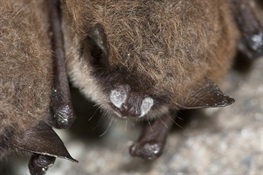 Credit: Larry Master Credit: Larry Master
Jan 9, 2020
1. The order in which individuals receive information about wildlife may influence their attitude toward wildlife differently which can have implications for how conservationists communicate messages about issues affecting wildlife.
2. In a study on bats, a risk-laden species also facing massive mortalities in North America due to white-nose syndrome (WNS), for people with high biospheric values (where the costs and benefits to ecosystems or the biosphere are at the center of individual decision making) reading a suffering message about WNS first led to a more positive attitude than reading a threat message about rabies first, whereas for people with low biospheric values reading a threat message first led to a more positive attitude than reading a suffering message first.
3. Knowing the target audience and their values can help conservation practitioners think strategically about designing messages on species traditionally portrayed as villains in the media (e.g., bats, sharks, wolves, lions); they should consider placing information that elicits compassion at the end of the message for those who may care less about the species and its conservation, and ensure that compassion-inducing information is the first piece of information for those who care more about the species and conservation.
WCS Media Contact: Stephen Sautner, 7182203682, ssautner@wcs.org
Study and Journal: "Scared yet compassionate? Exploring the order effects of threat versus suffering messages on attitude toward scary victims." from Science Communication
WCS Co-Author(s): Heidi Kretser
, Conservation Social Scientist
|
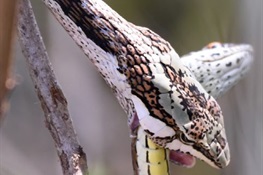 Credit: Sean de la Harpe‐Parker Credit: Sean de la Harpe‐Parker
Jan 9, 2020
1. Scientists have recorded the first-known case of cannibalism in African vine snakes, (Thelotornis spp.) -- a group of venomous snakes which inhabit savannah and forested regions across sub-Saharan Africa.
2. Instances of cannibalism are rarely recorded in African snakes.
3. Few detailed diet studies on these genera exist, which can lead to an underrepresentation of rare, but important, predation events, and further investigation into the cannibalistic tendencies is warranted.
WCS Media Contact: Stephen Sautner, 7182203682, ssautner@wcs.org
Study and Journal: "Ophiophagy and cannibalism in African vine snakes " from African Journal of Ecology
WCS Co-Author(s): Acácio Hélio Domingo Chechene
, WCS Mozambique Program
|
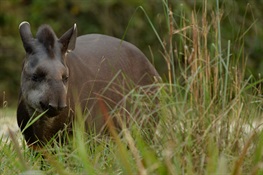 Credit: Pato Salcedo/WCS Credit: Pato Salcedo/WCS
Jan 9, 2020
1. Researchers present a new, spatially explicit, land-use planning framework that addresses the decision-making needed to account for different, competing economic-environment objectives (agricultural production value, biodiversity conservation, ecosystem service retention) when land use change is inevitable within an intact landscape.
2. They applied the framework to the globally significant savannahs of the Orinoquia (Colombia), which in a post-conflict era is under increased agricultural development pressure.
3. They identified planning solutions that perform well across all objectives simultaneously, despite trade-offs among them, providing an evidence base to inform proactive planning and the development of environmentally sensible agricultural development policy and practice in the region.
WCS Media Contact: Stephen Sautner, 7182203682, ssautner@wcs.org
Study and Journal: "Minimising the loss of biodiversity and ecosystem services in an intact landscape under risk of rapid agricultural development" from Environmental Research Letters
WCS Co-Author(s): Brooke Williams (Lead)
, WCS/University of Queensland
; Hedley Gantham, Conservation Science and Solutions; James Watson, Director, Science and Research Solutions; Silvia Alvarez, Field Consultant, WCS Colombia; German Forero-Medina , Species and Science Director, WCS Colombia
|
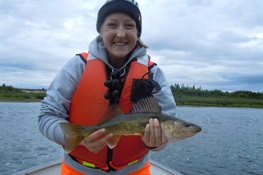 Credit: Alexandra Sumner Credit: Alexandra Sumner
Jan 9, 2020
1. Scientists investigated current patterns of mercury in walleye and white sucker across a climatic gradient in northern Ontario, Canada, to assess the possible influence of climate change, which is predicted to alter many processes in boreal aquatic ecosystems.
2. They found that drainage basin characteristics and lake water chemistry, not long-term mean temperatures or precipitation, were currently the strongest indicators of mercury in fish.
3. They conclude that mercury levels in fish is not strongly associated with current climatic conditions across northern Ontario but may be influenced by climate change in the future through indirect effects on water chemistry and food web structure.
WCS Media Contact: Stephen Sautner, 7182203682, ssautner@wcs.org
Study and Journal: "Mercury bioaccumulation in lacustrine fish populations along a climatic gradient in northern Ontario, Canada" from Ecosystems
WCS Co-Author(s): Gretchen Lescord
, WCS Canada
|
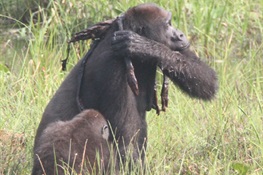 Credit: WCS Congo Credit: WCS Congo
Jan 9, 2020
1. Researchers working in the Congo’s Nouabale Ndoki National Park provide observations on a wild, female western lowland gorilla (Gorilla gorilla gorilla), who was observed to carry her dead infant for at least 16 days.
2. While several observations of behaviors towards dead members of the same species are available for chimpanzees, reports on other great ape species are less frequent.
3. Comparative observations in great apes and other nonhuman primates could reveal whether humans are unique in our ‘culturized’ ways to grieve.
WCS Media Contact: Stephen Sautner, 7182203682, ssautner@wcs.org
Study and Journal: "Attached beyond death: Wild female western lowland gorilla (Gorilla gorilla gorilla) carries and cares for mummified infant" from African Journal of Ecology
WCS Co-Author(s): Claudia Stephan (Lead)
, WCS Congo Program
|
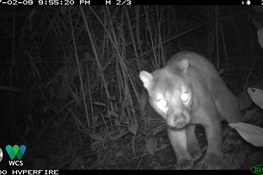 Credit: Bogani Nani Wartabone National Park and WCS Indonesia Program Credit: Bogani Nani Wartabone National Park and WCS Indonesia Program
Jan 9, 2020
1. There has been a 20-year lapse since the last field record of the Sulawesi civet (Macrogalidia musschenbroekii), which is found only on the Indonesian island of Sulawesi, where it is the largest mammalian predator.
2. Researchers set up 148 camera trap stations across the forests of North Sulawesi, including in two of its main protected areas: Bogani Nani Wartabone National Park and Tangkoko Nature Reserve, recording civets 17 times at 12 stations, and in almost equal numbers in primary forest, secondary forest and farmland, including the first photographic records from both the National Park and Nature Reserve.
3. The results show that neither IFL nor LWE identifies areas of ecologically intact fauna well enough, underscoring a strong need to obtain additional site-level survey data to confirm faunal intactness.
WCS Media Contact: Stephen Sautner, 7182203682, ssautner@wcs.org
Study and Journal: "New insights into Sulawesi's apex predator: The Sulawesi civet Macrogalidia musschenbroekii" from Oryx
WCS Co-Author(s): Iwan Honowu (Lead)
, WCS Indonesia program
; Alfons Patandung, Biodiversity Conservation Officer, WCS Indonesia; Wulan Pusparini, WCS Indonesia Program; Andi Nugraha Cahyana, GIS Specialist, WCS Inonesia program; Matthew Linkie , WCS Indonesia Program Director
|
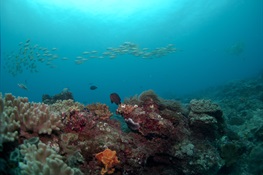 Credit: Emily Darling Credit: Emily Darling
Jan 9, 2020
1. Unsustainable fishing is a major driver of change in marine ecosystems, and the ways in which fishing gears target different species of fish with varying ecological functions are unclear.
2. Over a 7-year period, marine scientists examined whether artisanal fishing gear (spear guns, gillnets, beach seines, basket traps, etc.) selectively target fishes with unique combinations of traits (diet, body size, depth, schooling behaviour) in a coral reef ecosystem.
3. There were 163 unique combinations of traits analysed in the study, but half of the catches by each fishing gear type were linked to two to six trait combinations; banning specific gears will benefit species with certain trait combinations, but fishing effort reductions are still needed to alleviate pressure on fish populations.
WCS Media Contact: John Delaney, 7182657908, jdelaney@wcs.org
Study and Journal: "Functional traits illuminate the selective impacts of different fishing gears on coral reefs" from Journal of Applied Ecology
WCS Co-Author(s): Tim McClanahan
, Country Director, Kenya Marine
|
|